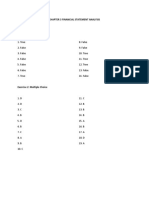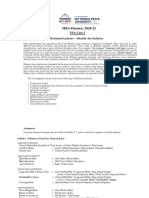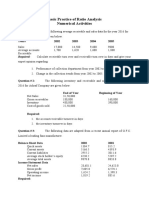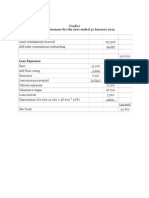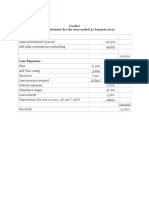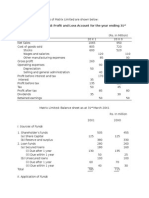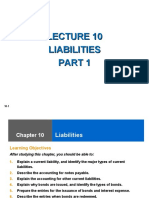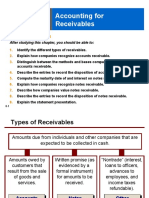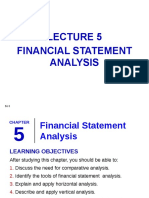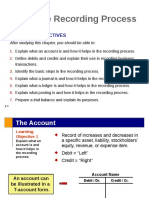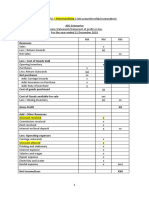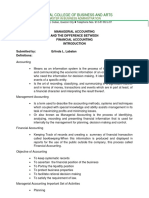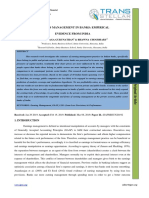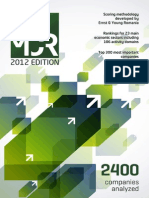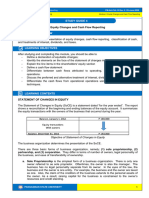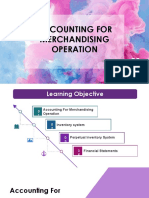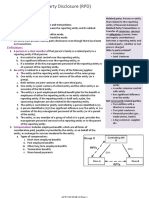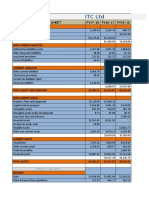FINANCIAL STATEMENT ANALYSIS
LECTURE 5 _ANSWER
QUESTION 1
(a) 2018 2019
(1) Profit margin.
£30,000 £44,000
£640,000 = 4.7% £700,000 = 6.3%
(2) Asset turnover.
£640,000 £700,000
£533,000 + £600,000 £600,000 + £640,000
2 2
= 1.1 times = 1.1 times
(3) Earnings per share.
£30,000 £44,000
31,000 = ₤0.97 32,000 = ₤1.38
(4) Price-earnings ratio.
£5.00 £7.00
£0.97 = 5.2 times £1.38 = 5.1 times
(5) Payout ratio.
£20,000* £22,000**
£30,000 = 66.7% £44,000 = 50.0%
*(₤113,000 + ₤30,000 – ₤123,000) **(₤123,000 + ₤44,000 – ₤145,000)
(6) Debt to assets.
1
� £162,000 £150,000
£600,000 = 27.0% £640,000 = 23.4%
b) PLS COMMENTS/COMPARE RATIO BETWEEN YEAR 2018 AND
YEAR 2019. ONE BY ONE. (USE YOUR OWN POINTS/SENTE
CES)
THIS IS SUMMARY ONLY
The underlying profitability of the corporation appears to have improved. For example, profit
margin and earnings per share have both increased. Also, the corporation appears to be
involved in attempting to reduce its debt burden as its debt to assets ratio has decreased.
Similarly, its payout ratio has decreased, which should help its overall solvency.
2
�QUESTION 2
(a) Ratio Target Wal-Mart
(All Dollars Are in Millions)
(1) Current .9:1 ($11,573 ÷ $12,777) .9:1 ($61,185 ÷ $69,345)
(2) Accounts receivable
turnover 24.9 ($72,596 ÷ $2,921) 70.8 ($476,294 ÷ $6,723)
(3) Average collection
period
14.7 (365 ÷ 24.9) 5.2 (365 ÷ 70.8)
(4) Inventory turnover
6.1 ($51,160 ÷ $8,335) 8.1 ($358,069 ÷ $44,331)
(5) Days in inventory
59.8 (365 ÷ 6.1) 45.1 (365 ÷ 8.1)
(6) Profit margin
2.7% ($1,971 ÷ $72,596) 3.3% ($16,022 ÷
(7) Asset turnover
1.6 ($72,596 ÷ $46,358a) $476,294)
(8) Return on assets
4.3% ($1,971 ÷ 2.3 ($476,294 ÷
(9) Return on ordinary a c
$46,358 ) $203,928 )
shareholders’ equity
7.9% ($16,022 ÷
(10) Debt to total assets
12.0% ($1,971 ÷ $203,928c)
(11) Times interest earned
$16,394.5b)
63.6% ($28,322 ÷ $44,553) 19.7% ($16,022 ÷ $81,538.5d)
3.8 ($4,229 ÷ $1,126) 60.3% ($123,412 ÷
$204,751)
11.3 ($26,462 ÷ $2,335)
a c
($44,553 + $48,163) ÷ 2 ($204,751 + $203,105) ÷ 2
b d
($16,231 + $16,558) ÷ 2 ($81,339 + $81,738) ÷ 2
(b) The comparison of the two companies shows the following:
(COMMENT RATIO BY RATIO)
THIS IS SUMMARY ONLY
Liquidity—Target’s current ratio of .9:1 is the same as Wal-Mart’s,
.9:1. However, Wal-Mart has a better inventory turnover ratio than
Target and its accounts receivable turnover is substantially better than
Target’s.
Profitability—Wal-Mart betters Target in all of the profitability ratios.
Thus, it is more profitable than Target.
3
� Solvency—Wal-Mart betters Target in both of the solvency ratios.
Thus, it is more solvent than Target.
QUESTION 3
MORGAN COMPANY
Comparative Statements of Financial Position
December 31,
———————————————————————————————————————
Assets 2019 2018
Property, plant, and equipment (net)...................................... $ 200,000 $ 160,000
Inventory................................................................................ 50,000 (8) 50,000
Accounts receivable (net)...................................................... 60,000 (6) 40,000
Short – term investments....................................................... 10,000 25,000
Cash........................................................................................ 30,000 45,000
Total assets..................................................................... $350,000 (9) $320,000
Equity and liabilities
Share capital – ordinary......................................................... $ 220,000 $ 200,000
Retained earnings................................................................... 60,000 35,000
Bonds payable........................................................................ 20,000 (10) 20,000
Accounts payable................................................................... 10,000 (7) 30,000
Short-term notes payable....................................................... 40,000 35,000
Total equity and liabilities ............................................. $350,000 (11) $320,000
MORGAN COMPANY
Statement of profit or loss
For the Year Ended December 31, 2019
———————————————————————————————————————
Net sales................................................................................. $200,000
Cost of goods sold.................................................................. 75,000
Gross profit............................................................................ 125,000
Expenses
Depreciation expense....................................................... $65,000 (5)
Selling expenses............................................................... 8,000
Administrative expenses.................................................. 12,000 85,000
Income from operations......................................................... 40,000 (4)
Interest expense...................................................................... 5,000
Income before income taxes.................................................. 35,000 (2)
Income tax expense................................................................ 10,000 (3)
Net income............................................................................. $ 25,000 (1)
(1) Net income = $25,000 ($200,000 × 12.5%).
(2) Income before income taxes = $35,000.
4
� Let X = Income before income taxes and interest expense.
X
——— = 8 times
$5,000
X = $40,000
$40,000 – $5,000 = $35,000
(3) Income tax expense = $10,000 ($35,000 – $25,000).
(4) Income from operations = $40,000 ($35,000 + $5,000).
(5) Depreciation expense = $65,000 [$85,000 – ($8,000 + $12,000)].
(6) Accounts receivable (net) = $60,000.
Let X = Average accounts receivable.
$200,000
———— = 4 times
X
4X = $200,000.
X = $50,000.
Let Y = Accounts receivable at 12/31/14.
$40,000 + Y
—————— = $50,000
2
$40,000 + Y = $100,000
Y = $60,000
(7) Accounts payable = $10,000.
Let X = Current liabilities.
$30,000 + $10,000 + $60,000
————————————— = 2
X
2X = $100,000
X = $50,000
$50,000 – $40,000 = $10,000
(8) Inventory = $50,000
Let X = Total current assets
X
———— = 3
$50,000
X = $150,000
$150,000 – ($30,000 + $10,000 + $60,000) = $50,000
(9) Total assets = $350,000 ($30,000 + $10,000 + $60,000 + $50,000 + $200,000)
(10) Bonds payable = $20,000
Let X = Total debt
5
� X
———— = 20%
$350,000
X = $70,000
$70,000 – ($10,000 + $40,000) = $20,000
(11) Total equity and liabilities = $350,000; same as total assets—see (9) above.
QUESTION 4
SPL (extract)
RM RM
Sales 255,490
Less: Cost of goods sold
Opening inventory 27,000
Purchase 148,000
Less: Closing inventory (29,000) (146,000)
Gross profit 109,490
Add: Other revenue 7,500
Less: Expenses
Administrative expense 35,322
Selling expense 23,559
Financial expense 22,011 (80,892)
Net profit 36,098
SOFP (extract)
RM RM
Current assets
cash 5,439
Account receivables 59,425
Closing inventory 29,000 93,864
Property, plant and equipment
Motor vehicles 90,000
Total assets 183,864
Current liability
Account payable 51,443
Bank overdraft 15,666 67,109
Long term loan 100,000
Total liability 167,109
6
� Formula Calculation
a) Gross profit/ Net sales 109,490/255,490
= 0.43
b) Net profit/Net sales 36,098/255,490
= 0.14
c) COGS/Average inventory 146,000/28,000
= 5.21 times
d) Current asset/current liability 93,864/67,109
= 1.4:1
e) Net credit sales/average net account 255,490/59,425
receivable = 4.3 times
f) Total liability/total asset 167,109/183,864
= 0.91


